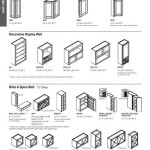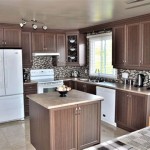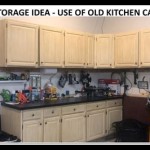Knockdown Kitchen Cabinets: A Comprehensive Overview
Knockdown kitchen cabinets, often abbreviated as KD cabinets, represent a significant sector within the cabinetry market. These cabinets are shipped unassembled, requiring on-site assembly by the purchaser or a contractor. This construction method offers a range of advantages and disadvantages compared to pre-assembled or custom-built cabinetry. This article provides a comprehensive overview of knockdown kitchen cabinets, exploring their construction, benefits, drawbacks, cost considerations, installation processes, and suitability for various kitchen remodeling projects.
The design and construction of KD cabinets prioritize efficient shipping and storage. Components are precisely cut and often pre-drilled at the factory, ensuring accurate alignment during assembly. The materials used in knockdown cabinets vary widely, ranging from particleboard and MDF (Medium-Density Fiberboard) to plywood and solid wood. The choice of material significantly impacts the durability, aesthetics, and overall cost of the cabinets. The finishing options also span a broad spectrum, including laminates, veneers, paint, and stain, allowing for customization to match various kitchen styles.
Assembly typically involves connecting the individual panels using screws, cam locks, or dowels. Cam locks, in particular, are a frequent feature in KD cabinet construction, providing a secure and concealed fastening method. Instructions are crucial for successful assembly, and manufacturers generally provide detailed diagrams and step-by-step guides. While some individuals with carpentry skills may find KD cabinet assembly straightforward, others may prefer to hire a professional installer to ensure proper construction and alignment.
Cost-Effectiveness and Budget Considerations
One of the primary advantages of knockdown kitchen cabinets is their lower cost compared to pre-assembled or custom-built options. This cost reduction stems from several factors. First, the flat-pack shipping of unassembled components significantly reduces transportation expenses. Second, manufacturers can streamline production processes by focusing on standardized sizes and designs. This efficiency translates to lower labor costs per unit. Third, the self-assembly aspect shifts some of the labor burden onto the purchaser, further reducing the overall price.
However, it is important to consider the potential for hidden costs when evaluating the cost-effectiveness of KD cabinets. The time required for assembly should be factored in, especially for larger kitchens or complex cabinet configurations. Hiring a professional installer, while increasing the upfront cost, can save time and ensure a higher quality installation. Additionally, the quality of the materials and hardware used in KD cabinets can vary widely. Selecting lower-quality options can lead to premature wear and tear, potentially offsetting the initial cost savings in the long run.
When budgeting for knockdown kitchen cabinets, it is advisable to obtain quotes from multiple suppliers and compare the specifications of the cabinets carefully. Pay close attention to the material composition, hardware quality, and warranty offered. Researching user reviews and seeking recommendations from experienced home renovators can also provide valuable insights into the long-term value of different KD cabinet brands and models. Furthermore, remember to account for additional expenses such as installation tools, adhesives, and any necessary modifications to the existing kitchen layout.
Shipping, Storage, and Handling
The flat-pack design of knockdown kitchen cabinets simplifies shipping and storage logistics. The compact packaging minimizes space requirements in warehouses and during transportation. This is particularly advantageous for homeowners with limited storage space or those undertaking renovations in apartments or other dwellings with restricted access. The reduced volume also often translates to lower shipping costs, especially for online purchases delivered directly to the home.
However, the handling of KD cabinet components requires careful attention to prevent damage. The flat-pack design, while efficient for shipping, can make the individual panels more susceptible to scratching, denting, or warping if mishandled. It is crucial to store the components in a dry, protected environment away from direct sunlight and extreme temperatures. The panels should be stacked horizontally on a flat, stable surface to prevent bending or distortion. When moving the components, use proper lifting techniques and avoid dragging them across rough surfaces.
Before commencing assembly, it is recommended to unpack and inspect all components thoroughly. Verify that all parts are present and undamaged. Compare the components to the inventory list provided by the manufacturer. Any discrepancies or defects should be reported to the supplier promptly. Taking photographs of any damage upon delivery can be helpful when filing a claim. Careful planning and organization of the components before assembly can streamline the process and minimize the risk of accidental damage.
Assembly Process and Installation Considerations
The assembly process for knockdown kitchen cabinets typically involves several key steps. First, carefully read and understand the manufacturer's instructions. Familiarize yourself with the different components and their designated locations in the cabinet structure. Second, gather the necessary tools, including screwdrivers, drills, levels, measuring tapes, and clamps. A power drill with various bits can significantly speed up the assembly process. Third, assemble the cabinet boxes according to the instructions. This usually involves joining the side panels, top and bottom panels, and back panel using screws, cam locks, or dowels.
Proper alignment is crucial for ensuring the structural integrity and aesthetic appeal of the assembled cabinets. Use a level to verify that the cabinet box is square and plumb. Clamps can be used to hold the panels securely in place while the fasteners are tightened. Avoid over-tightening the screws or cam locks, as this can damage the particleboard or MDF core. Once the cabinet box is assembled, install the doors, drawers, and hardware. Adjust the hinges and drawer slides to ensure smooth operation and proper alignment.
The installation of knockdown kitchen cabinets involves mounting the assembled cabinets to the wall. Before installation, locate the wall studs and mark their positions. Use a stud finder to ensure accurate placement. Install a ledger board to support the base cabinets during installation. This will prevent the cabinets from sagging or shifting. Lift the cabinets into place and secure them to the wall studs using screws. Ensure that the cabinets are level both horizontally and vertically. Shim the cabinets as needed to compensate for uneven floors or walls. Once the base cabinets are installed, proceed to install the upper cabinets. Exercise caution when lifting heavier upper cabinets. Use appropriate safety equipment, such as safety glasses and work gloves, throughout the installation process.
The success of a kitchen renovation project involving knockdown cabinets largely hinges on meticulous planning, accurate measurements, and careful execution of the assembly and installation processes. While self-assembly can be a cost-effective option, professional installation is often recommended for achieving optimal results. Understanding the nuances of KD cabinet construction and installation is essential for making informed decisions and ensuring a durable and aesthetically pleasing kitchen. The choice between different materials, finishes, and hardware options should be guided by budget constraints, desired durability, and overall design aesthetic. Careful consideration of these factors will contribute to a successful and satisfying kitchen renovation experience.

Knockdown Cabinets Home

High End Knockdown Modern Wooden Green Gloss Uv Kitchen Cabinets China With Precut Granite Countertops Mdf Cabinet Furniture Made In Com

Knockdown Cabinets Home
:strip_icc()/101506866-9f029ac677fc420f851e9b9143c17755.jpg?strip=all)
Tips For Affordable And Stylish Cabinets Your Kitchen

Condo Remodel Walls Removed Knockdown Ceiling Kitchen 2 Baths Family Room Dining Bedroom Manufactured Home

A Design Minded Guide To Functional Kitchen Cabinets

Kitchen Cabinets Metal Imported Knockdown System Cabinet In Ojo Furniture C J Normal Industries Ltd Jiji Ng

Flat Pack Kitchens Affordable Customizable Solution Oppolia

How To Refinish Kitchen Cabinets Look New Refinishing 101

Highland Black Shaker Rta Kitchen Cabinets Accent Color Wood
Related Posts








